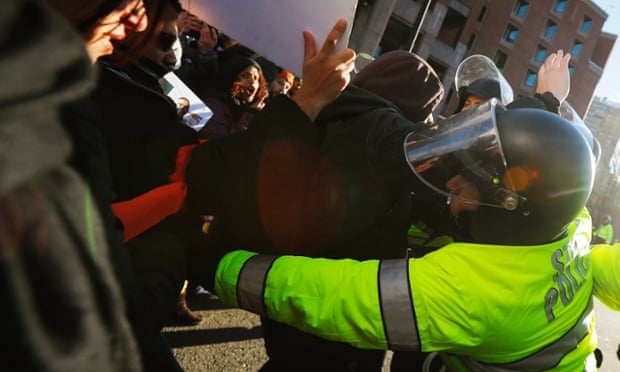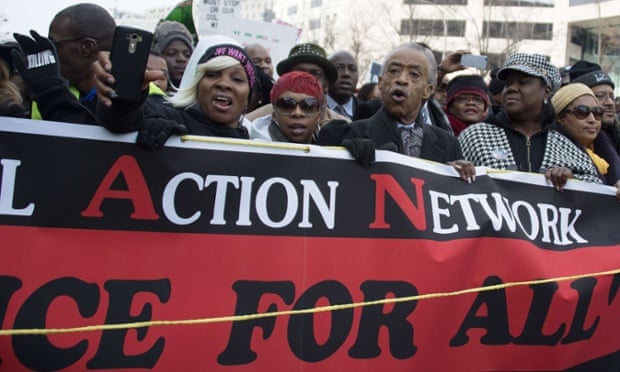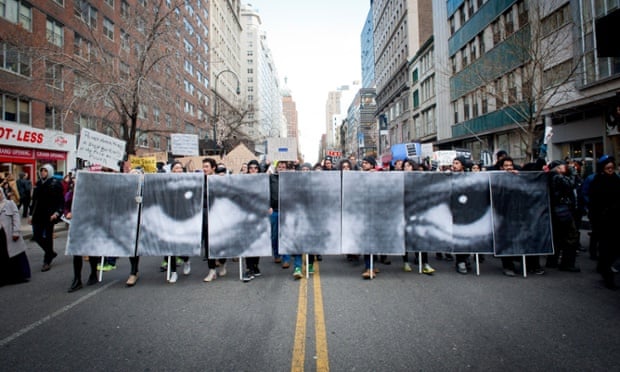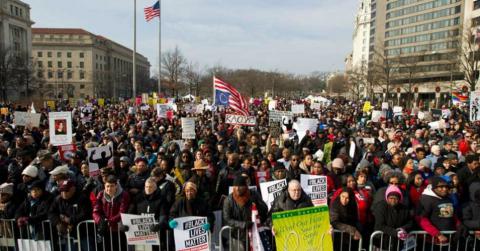Thousands of Americans took to the streets on Saturday in Washington, New York, and several other cities to protest recent grand jury decisions regarding the deaths of black men at the hands of police officers.
Grand jury decisions in Missouri, regarding the death of Michael Brown, and New York, regarding the death of Eric Garner, have unleashed a torrent of demonstrations across the country and hurled long-simmering tensions over racial injustice and police brutality into the national spotlight.
More than 20 people were arrested in Boston on Saturday, as hundreds gathered around the Massachusetts state capitol amid a heavy police presence. Largely peaceful protests took place in Chicago and Oakland.
The demonstrations were dubbed a “day of resistance”, against what protesters believe is rampant police brutality against people of color, especially young black men.
In New York, thousands marched from Washington Square Park uptown, via 6th Avenue, before turning downtown to progress along Broadway and to NYPD headquarters at One Police Plaza. Later, after darkness had fallen, protesters attempted to stop traffic on the Brooklyn Bridge.
In Washington, throngs of protesters – black, white, young and old – wound their way down Pennsylvania Avenue to the Capitol on a chilly December day. Among them were around 400 protesters who came by bus from Ferguson, the site of Brown’s death in August and sizeable protests since.
Near the Capitol, the veteran civil rights campaigner Reverend Al Sharpton was joined onstage by relatives of men killed by law enforcement officers.
Those represented by family members included Brown, an unarmed 18-year-old shot who was dead by a white police officer in Ferguson in August; Garner, 43, who was killed in July after a police officer on Staten Island placed him in a banned chokehold; Tamir Rice, a 12-year-old shot dead by police in Cleveland in November; Akai Gurley, a 28-year-old shot dead in Brooklyn last month; Trayvon Martin, a 17-year-old shot dead by a neighborhood watch leader in 2012 in Florida; and Amadou Diallo, who was shot 41 times by New York police officers in 1999.
 Police officers scuffle with protestors in Boston, where more than 20 arrests were made. Photograph: Brian Snyder/Reuters
Police officers scuffle with protestors in Boston, where more than 20 arrests were made. Photograph: Brian Snyder/Reuters
“What a sea of people,” said Brown’s mother, Lesley McSpadden. As she spoke, people in the crowd shouted: “We love you.”
McSpadden continued: “If they don’t see this and make a change, then I don’t know what we got to do. Thank you for having my back.”
Garner’s family wore sweatshirts which bore the words “I can’t breathe”, the final words the 43-year-old father gasped before his death, which have become a slogan of solidarity used by sports stars, among others.
“This is a history making moment,” said Garner’s mother, Gwen Carr. “It’s just so overwhelming to see all who have come to stand with us. Look at the masses black, white, all races, all religions … we need to stand like this at all times.”
In Oakland, the mother of Oscar Grant, a young black man whose fatal encounter with an transit police officer in 2009 inspired the recent film Fruitvale Station, spoke to a crowd gathered outside the Alameda county court house.
“We want officers to be held accountable for their actions… feel that pain just as we have to feel it,” Wanda Johnson said.
The Oakland march was estimated to be 3,500-strong.
In Washington, Sharpton electrified a larger audience, as he has done many times this year at funerals and protests.
“We don’t come to Washington as shooters and chokers,” he shouted. “We come as the shot and the choked, asking you to help deal with the American citizens who can’t breathe in their own communities.
 Reverend Al Sharpton and Lesley McSpadden, mother of Ferguson shooting victim Michael Brown, lead the “Justice For All” march in Washington. Photograph: Jim Watson/AFP/Getty Images
Reverend Al Sharpton and Lesley McSpadden, mother of Ferguson shooting victim Michael Brown, lead the “Justice For All” march in Washington. Photograph: Jim Watson/AFP/Getty Images
“This is not a black march or a white march,” he added. “This is an American march.”
Sharpton is urging legislative action that would allow the federal government to intervene in investigations of officer-involved shootings. He warned members of Congress to “beware” because the protesters “are serious”. “When you get a ring-ding on Christmas, it might not be Santa,” he said. “It may be Rev Al coming to your house.”
Among the throng listening intently to the speakers was Tiffany Proctor and her two young sons, Ahmir, 8, and Ahmar, 10. Despite the cold, Proctor told the Guardian she wanted her sons to witness the protest.
“These are my future,” Proctor said, placing her hands on her sons’ shoulders. “And this is their future. The way things are going - it isn’t right.”
“It’s sad that there’s racism,” Ahmar said quietly.
The family had made signs to carry at the protests. Each boy had traced his small hands on his poster and written: “Don’t shoot me.”
Throughout the New York march, demonstrators chanted: “Eric Garner, Michael Brown. Shut it down. Shut it down.”
 Protesters march in New York, carrying signs making up the eyes of Eric Garner. Photograph: Zuma/Rex
Protesters march in New York, carrying signs making up the eyes of Eric Garner. Photograph: Zuma/Rex
Protesters leading the way carried signs that combined to display Eric Garner’s eyes. Estimates of the size of the crowd varied widely, between 10,000 and 50,000. Before the protest reached the Brooklyn Bridge police, who did not offer a crowd figure, said no arrests had been made.
Four young boys carrying signs that said “Stop the racist killer cops!” told the Guardian they decided to join the protest after hearing that fellow students in Brooklyn had been arrested during a earlier protest in Times Square.
“We’re hear marching for justice,” Gilead, 13, told the Guardian. Eli, 13, added: “What’s happening is not right.”


Spread the word